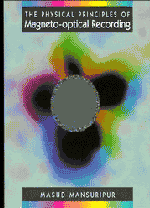Book contents
- Frontmatter
- Contents
- Preface
- 1 Overview of Optical Data Storage
- 2 Optics of Gaussian Beams
- 3 Theory of Diffraction
- 4 Diffraction of Gaussian Beams from Sharp Edges
- 5 Optics of Thin Films and Multilayers
- 6 Magneto-optical Readout
- 7 Effects of High-numerical-aperture Focusing on the State of Polarization
- 8 Computer Modeling of the Optical Path
- 9 Noise in Magneto-optical Readout
- 10 Modulation Coding and Error Correction
- 11 Thermal Aspects of Magneto-optical Recording
- 12 Fundamentals of Magnetism and Magnetic Materials
- 13 Magnetostatics of Thin-film Magneto-optical Media
- 14 Mean-field Analysis of Amorphous Rare Earth–Transition Metal Alloys
- 15 Magnetization Dynamics
- 16 Origins of Coercivity
- 17 The Process of Thermomagnetic Recording
- 18 Media Characterization
- References
- Index
11 - Thermal Aspects of Magneto-optical Recording
Published online by Cambridge University Press: 07 September 2010
- Frontmatter
- Contents
- Preface
- 1 Overview of Optical Data Storage
- 2 Optics of Gaussian Beams
- 3 Theory of Diffraction
- 4 Diffraction of Gaussian Beams from Sharp Edges
- 5 Optics of Thin Films and Multilayers
- 6 Magneto-optical Readout
- 7 Effects of High-numerical-aperture Focusing on the State of Polarization
- 8 Computer Modeling of the Optical Path
- 9 Noise in Magneto-optical Readout
- 10 Modulation Coding and Error Correction
- 11 Thermal Aspects of Magneto-optical Recording
- 12 Fundamentals of Magnetism and Magnetic Materials
- 13 Magnetostatics of Thin-film Magneto-optical Media
- 14 Mean-field Analysis of Amorphous Rare Earth–Transition Metal Alloys
- 15 Magnetization Dynamics
- 16 Origins of Coercivity
- 17 The Process of Thermomagnetic Recording
- 18 Media Characterization
- References
- Index
Summary
Introduction
All media in use today for laser-assisted recording rely on the associated rise in temperature to achieve a local change in some physical property of the material. Therefore the first step in analyzing the write and erase processes is the computation of temperature profiles. Except in very simple situations, these calculations are done numerically using either the finite difference method or the finite element technique. Generally speaking, the two methods produce similar results in comparable CPU times. Most often one assumes a flat surface for the disk and circular symmetry for the beam, which then allows one to proceed with solving the heat diffusion equation in two spatial dimensions (r and z in cylindrical coordinates). For more realistic calculations when the disk is grooved and Preformatted, or when the beam has asymmetry due to aberrations or otherwise, the heat absorption and diffusion equations must be solved in three-dimensional space.
A problem with the existing thermal models is that the optical and thermal parameters of the media are assumed to be independent of the local temperature. In practice, as the temperature changes, these parameters vary (some appreciably). While it is rather straightforward to incorporate such variations in the numerical models, at the present time it is difficult to obtain reliable data on the values of thermal parameters at a fixed temperature, let alone their temperature dependences. It is hoped that some effort in the future will be directed towards the accurate thermal characterization of thin-film media.
- Type
- Chapter
- Information
- The Physical Principles of Magneto-optical Recording , pp. 350 - 391Publisher: Cambridge University PressPrint publication year: 1995
- 1
- Cited by



